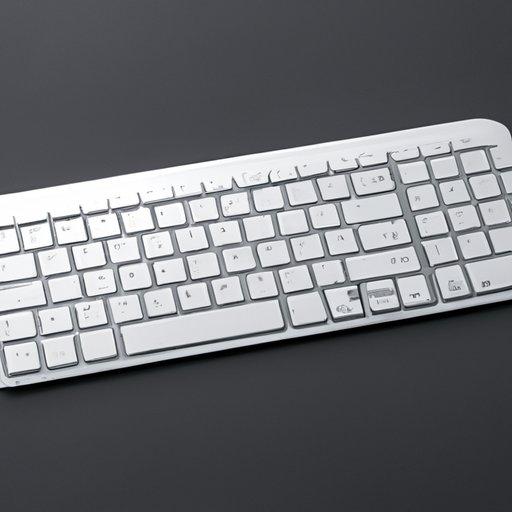
Introduction
Wireless keyboards have become increasingly popular over the years, and with good reason. They are convenient, portable, and can be used across multiple devices. However, many people are not fully aware of how to connect and maintain their wireless keyboards, which can lead to frustration and disruption to their work. This article aims to provide a comprehensive guide to connecting and maintaining your wireless keyboard.
A Step-by-Step Guide to Connecting Your Wireless Keyboard
Connecting your wireless keyboard may seem daunting, but it is a straightforward process. Here are the steps you need to follow:
1. Turn on your keyboard and ensure it has batteries. You may also need to expose a “Connect” button on the keyboard.
2. Press the “Connect” button on the keyboard. This will put the keyboard into pairing mode.
3. On your device, navigate to the Bluetooth settings. Make sure that your Bluetooth is turned on and discoverable.
4. Click on “Add a Bluetooth device.” Your device should now show a list of discoverable Bluetooth devices.
5. Select your wireless keyboard from the list of available devices.
6. Follow any additional prompts that may appear to complete the connection process.
7. Once connected, test your keyboard to ensure it is functioning correctly.
Tips and Tricks for Connecting Your Wireless Keyboard
While connecting your wireless keyboard is straightforward, there are some tips and tricks you can use to optimize your connection and improve your user experience. Here are some suggestions:
– Make sure that your device is within range of the keyboard. If your device is too far away, it may struggle to maintain a connection.
– Check for any interference sources. Other wireless devices in the area, such as routers or other keyboards, can cause connectivity issues. You can try moving your device or keyboard to a new location to minimize these issues.
– Check for software updates. Regular updates can improve the performance of your keyboard and fix any known issues.
– Optimize your keyboard settings. You can customize the function of your keys and set up shortcuts to increase your productivity.
Wireless Keyboard Connection for Beginners
For those new to wireless keyboards, the process may seem intimidating. However, it is a worthwhile investment and can drastically improve your work experience. Here is a general overview of how to connect to a wireless keyboard:
1. Turn on the keyboard and ensure it has batteries.
2. Put the keyboard into pairing mode by pressing the “Connect” button.
3. On your device, navigate to the Bluetooth settings and click on “Add a Bluetooth device.”
4. Select your wireless keyboard from the list of available devices.
5. Follow any additional prompts that may appear to complete the connection process.
6. Test your keyboard to ensure it is functioning correctly.
Wireless keyboards offer several advantages over traditional wired keyboards. They are portable, convenient, and can be used across multiple devices, making them ideal for people who work on the go or switch between devices regularly.
Troubleshooting Common Wireless Keyboard Connection Problems
Even with proper connection, some issues may arise with your wireless keyboard. Here are some common problems you may encounter and how to solve them:
– Connectivity problems: If your keyboard is not connecting to your device, try resetting both your device and keyboard and repeating the pairing process.
– Lag: If you experience lag with your keyboard, try moving it closer to your device or minimizing potential interference.
– Unresponsive keys: If your keyboard keys are not responding, try resetting your keyboard or device or checking for any software updates.
How to Make the Most of Your Wireless Keyboard Connection
Wireless keyboards offer several unique features that can optimize your work experience. Here are some ways to make the most of your wireless keyboard connection:
– Customize your keyboard settings to suit your preferences. You can set up shortcuts and macros to increase your productivity.
– Program your keyboard for multimedia use. Use your keyboard to control volume or media playback.
– Use your keyboard to increase your work productivity. By optimizing your shortcuts and using your keyboard to navigate through documents and files, you can save valuable time.
Connecting Wireless Keyboards to Different Devices
Wireless keyboards can be used across multiple devices, including laptops, smartphones, and tablets. Here are some specific instructions for how to connect your keyboard to different devices:
– Laptops: Follow the same steps outlined in Section II to connect your keyboard to your laptop.
– Smartphones: On your smartphone, navigate to the Bluetooth settings and put your device into pairing mode. Follow the same steps outlined in Section II to connect to your keyboard.
– Tablets: Follow the same steps outlined in Section II to connect your keyboard to your tablet.
Each device may have its specific additional steps to complete the connection process. Refer to the user manual for more information.
Maintaining Your Wireless Keyboard Connection
Maintaining your wireless keyboard connection is essential to prolonging the lifespan of your device and minimizing any issues that may arise. Here are some tips for maintaining your wireless keyboard connection:
– Keep your keyboard clean and free of debris. This can minimize wear and tear and improve performance.
– Ensure your keyboard has adequate battery life. Replace batteries as necessary.
– Check for any software updates regularly. This can improve performance and fix any known issues.
Conclusion
Connecting and maintaining your wireless keyboard may seem intimidating at first, but with these step-by-step instructions, tips and tricks, and troubleshooting strategies, you can set up your keyboard with ease. Remember to maintain your device regularly to ensure optimal performance, and enjoy the convenience and portability of your wireless keyboard.





